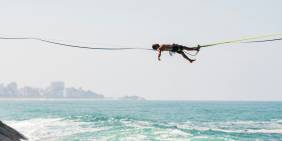
Two heads, one body

Te Papa’s board has implemented a new strategy and a cooperative leadership model to change the organisation's culture and expand its reach.
Te Papa Tongarewa Museum of New Zealand has come a long way from its humble beginnings in 1865, housed in a small building behind Parliament. Now, its looming Lego-like façade dominates the capital’s waterfront.
Despite being built close to a fault line on spongy, reclaimed soil, it’s famously regarded as one of the safest places in Wellington should a major earthquake hit – thanks to the 152 large rubber blocks which isolate the structure from the unpredictable ground beneath.
Yet, even the most impressive engineering feats couldn’t help Te Papa avoid the shock of a global pandemic.
Covid closes doors
Te Papa Chair Dame Fran Wilde CFInstD says covid-19’s impact was dramatic and immediate.
“We simply closed our doors and our commercial operations virtually ceased. Not many people realise that, although Te Papa is government owned, it has to earn about 40% of its revenue from its own activities. Things like events, conferences, dinners, paid tours and retail,” Wilde says.
Pre-pandemic, Te Papa welcomed around one and half million visitors a year through its doors, more than half of these from overseas – a cohort that tends to spend the most. But big conferences and events were either cancelled or postponed.
Wilde says that, despite this, staff wellbeing was management’s chief concern, a focus the board strongly supported.
“One of the board’s priorities was to improve staff engagement, which by 2019 had fallen to an historic – and well publicised – low. Alongside senior leadership, we’d put in place the building blocks needed for a fully-engaged staff, with a new board committee – the Tikanga Tangata Committee – to oversee delivery.
“Our employees are the most important ingredient in Te Papa’s success,” she says. And in challenging circumstances, staff did the organisation proud.
“Staff thought laterally to reimagine other commercial opportunities within the parameters of the pandemic, from retail to small group events,” Wilde says.
Lockdown also upped the pace of digitisation.
“Te Papa has a well-developed educational role and is a key information source for thousands of people. We’d wanted to expand our virtual delivery in these areas anyway. The pandemic gave us greater impetus.”
“Not many people realise that, although Te Papa is government owned, it has to earn about 40% of its revenue from its own activities. Things like events, conferences, dinners, paid tours and retail.”
Changing of the guard
Covid-19 followed hot on the heels of considerable change at Te Papa’s helm. Wilde was appointed chair in July 2019, while the board itself was refreshed with a number of new directors. Around the same time, they launched the search for a new CEO, or Tumu Whakarae.
Wilde says Te Papa’s strong global reputation meant the role attracted a lot of international interest. But the board was clear about what it wanted.
“We agreed we needed someone who could deliver transformational change and who also deeply understood the museum sector, te ao Māori and New Zealand culture generally,” she says.
“I personally felt that if the right candidates were available, it might be time for a woman in the role, while a younger perspective would help us deliver for the future, which is a fundamental part of our mandate.
“We found all these characteristics in an internal candidate – Courtney Johnston. The fact she didn’t need to learn about the organisation was a bonus, because a few months after her appointment, covid-19 arrived,” Wilde says.
Ultimately, like all businesses, the pandemic forced Te Papa to adjust and learn how to do things differently. However, while it might’ve delayed progress in some areas, it did not change the overall trajectory of the organisation’s strategy.
The public sector’s only bi-cultural leadership model
Wilde says a key priority of that strategy was rejuvenating Te Papa’s bi-cultural kaupapa.
“The bi-cultural leadership model had clearly weakened over the years and we needed to support that as the base for other changes, both within and outside the museum.”
This model is unique in the public sector and, therefore, uniquely challenging – not least because the organisation’s governing legislation envisaged only one CEO.
“We have a Tumu Whakarae and a Kaihautu. In other organisations the Kaihautu or “Māori advisor” is not usually at the same level as the CEO, so the formal line of accountability is singular and clear,” she says.
“Honestly, it’s been an exploration for all of us and it’s not over yet. We searched, but couldn’t find many useful models. We also looked at Te Papa’s history and the expectations of iwi in particular.”
She says they’ve made great progress, but admits there’s been some trial and error on things like key performance indicators – joint, complementary or both?
Meanwhile, advice from people like Public Service Commissioner Peter Hughes has helped the board work out how to achieve its desired outcomes within the context of the public sector legislation.
“We’re extremely fortunate that the current Kaihautu – Arapata Hakiwai – is not only knowledgeable and experienced, but very highly regarded in te ao Māori. Both Arapata and Courtney now report directly to the board and we’ve been able to draw on their complementary strengths to re-position and reinforce the bi-cultural model,” Wilde says.
“Te Papa works around the motu with iwi in both the Treaty settlement process (including the return of taonga) and also post settlement.”
The wider context
Te Papa’s board has also become more engaged in the organisation’s work outside the museum’s walls.
“The renewed bi-cultural kaupapa includes fostering closer relations with the mana whenua of our region,” she says.
“Te Papa works around the motu with iwi in both the Treaty settlement process (including the return of taonga) and also post-settlement. The board is keen to be involved and we’ve scheduled meetings outside of Wellington to facilitate this… although many have been thwarted by covid.”
Te Papa’s leadership role in the museum and gallery sector has also undergone a revival, something the board actively supports. Wilde says Te Papa worked closely with the Ministry of Culture and Heritage during the pandemic to help smaller players in the sector.
“I’m hosting an event soon for those in museum and gallery governance positions around the motu. This is an important initiative to link boards into current strategic thinking in the sector and is something I hope we can do every year,” Wilde says.
“I like to think we’re changing attitudes towards ‘big sister’ Te Papa.”
Repairing strained relationships
It’s not just relationships within the sector that are important to Te Papa. Wilde says external colleagues are critical for the organisation to deliver its mandate, whether in collaborative research, science, arts or education.
“For a number of reasons, our relationship with members of the science and research community had become strained. And we had no practical relationship at all with the primary sector. This was something we, as a board, wanted to change.”
She says the organisation reached out at both board and management level and were welcomed in return.
“The board’s role has been particularly critical. We have regular meetings scheduled in our timetable to make sure we get to engage with as many of these colleagues as possible.”
“I’m hosting an event soon for those in museum and gallery governance positions around the motu. This is an important initiative to link boards into current strategic thinking in the sector and is something I hope we can do every year.”
Pushing for progress on repatriation
Te Papa has made headlines both at home and abroad for its leadership role in the now well-established practice of repatriating human remains. Wilde says the board is not only wholly supportive of this work, but firmly believes the organisation should lead by example and go much further.
“There are thousands of objects in our museum that will never see the light of day. Some of these will have, at some point, been stolen from their source communities – often frighteningly recently.
“We believe that museum practice should be anchored in a partnership with the community and that the source community of any taonga is an entirely appropriate place for it to be treasured.
“This will be a difficult conversation in the museum community, here and overseas. But, in my view, it’s a necessary one. Moving down this path will require very close working relationships outside the museum, which can only be positive,” she says.
Diversity in action
Wilde says Te Papa’s board has very open discussions and is always keen to find creative solutions.
“It’s without doubt the most diverse board I’ve worked with in terms of gender, ethnicity, occupation and geography. And I’ve yet to find an issue or challenge that the board wants to sweep under the carpet.
“At the same time, we’re keenly aware of our legal responsibilities as board members, as well as our responsibility to our shareholder – the government – and to New Zealanders as a whole,” she says.
“Governing Te Papa is about creating a legacy for future Kiwis, whether they be tangata whenua or tangata Tiriti. We want them all to feel comfortable at ‘our place’ – which we consider ‘their place’ – and use Te Papa to engage in important conversations.
“It will always be a museum and art gallery, run education outreach, service other museums and galleries, and engage in science and research. But it should also be at the heart of Aotearoa’s ongoing process of celebrating and defining our national identity.”


